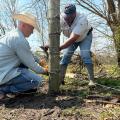First Aid Helps Injured Animals
A lot of emergency first aid that works for injured humans also helps injured animals. People can do a lot to help injured animals. The goal is to get the animal quickly and safely to a veterinarian.
Common injuries requiring first-aid for animals are bite wounds, gunshot wounds, or injuries from being hit by a car. The first thing to do, whether helping a pet or a wild animal, is to make sure the animal cannot hurt any person.
Any time an animal is injured, it may be in pain and fearful, so it may try to bite you, especially if you try to touch the part that is hurt. With dogs, a soft cord or long strips of gauze wrapped around the muzzle and tied behind the head prevents it from snapping. The animal then can be wrapped in a large blanket and taken to the veterinarian. Cats can simply be wrapped in a blanket and carried to the veterinarian.
A good way to transport an injured animal is wrapped in a blanket and placed in an airline carrier. Being quiet and covering the animal's eyes calms the animal and make it easier to handle.
If the animal is unconscious, treat it as you would a possible spinal injury for a person. Wrap the animal on a board so its legs, spine and neck are stiff and take it to the veterinarian.
Especially with an unconscious animal, make sure the airway is clear and breathing is not blocked. Use a cloth to clear the mouth and protect your hand from possible bites.
If an animal is bleeding, the first-aid treatment is the same for animals and humans. Apply steady pressure with gauze or a clean towel to limit the blood flow.
Dangling, broken legs can be temporarily immobilized with splints made of newspaper, cardboard, or towels. Run cold water over minor burns to ease some of the pain temporarily.
Avoid giving animals pain medication. Aspirin can be used in some cases, but only under the direction of a veterinarian.
For most injured wild animals or in any situation where a person is in danger of being hurt, a conservation officer or animal control officer should be called to help. Once the animal has been confined, it should be taken to the veterinarian.
Everyone should have a list of veterinarians to call for help before being faced with an injured animal. Not all veterinarians work with wild animals, and not all offices handle after-hours emergencies.
When you have an injured animal, don't immediately take it to the nearest veterinarian. Call first to make sure somebody is there who can treat the animal.
Publications
News
EGYPT, Miss. -- On hot days, Robert Thompson’s beef cows used to retreat to a cluster of trees in the middle of his pasture for shade.
STARKVILLE, Miss. -- After natural disasters, food and shelter are prioritized well above mental health, but ignoring emotional distress can lead to serious physical health conditions.
STARKVILLE, Miss. -- A Mississippi State University Extension program coordinator will serve as chair of the Extension Disaster Education Network, EDEN, for a two-year term.






